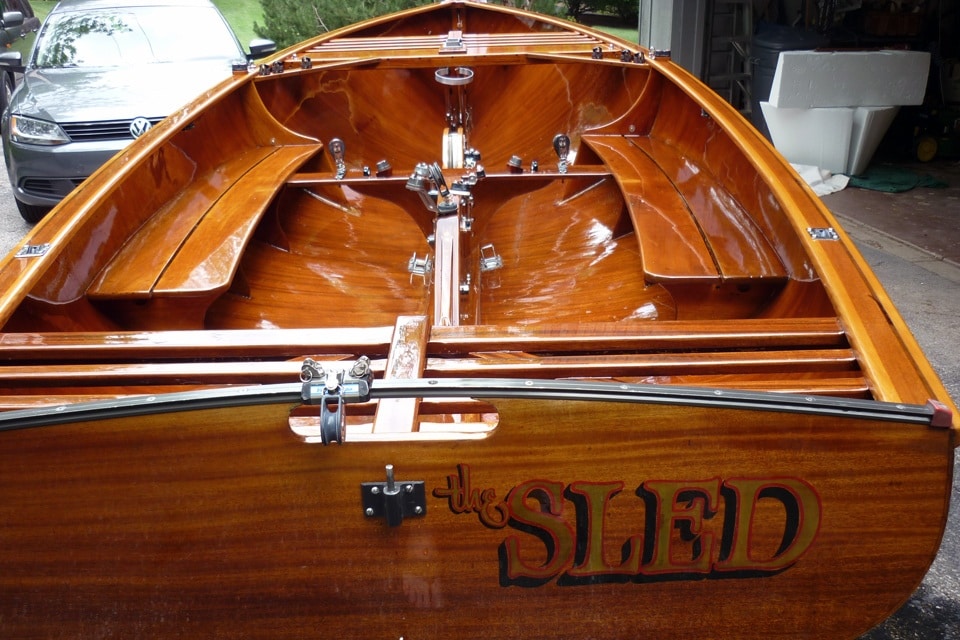
Sled vs VW
Have you been eagerly following this Tough Sledding series? Were you beginning to wonder what became of my boat project?
My radio silence in recent weeks could indicate that I’ve fizzled out, put down my sandpaper, and left the Thistle partially refinished in Mom’s garage. And I’ll admit, I had my doubts—especially as Memorial Day passed, the lawn needed mowing, and there was that crib to assemble.
But I’m proud to say that we’ve finally finished our refit, and the Sled is ready to splash! As you read this, I could be dropping in the centerboard and hoisting the main.
The project has been slow going from the start, and as we came within sight of the finish, the wind seemed to die. It’s not that I lost interest. Actually, quite the opposite: Seeing how nicely the boat was turning out, I began to enjoy myself. I’ve been taking more and more care to ensure that I don’t spoil the finishing touches.
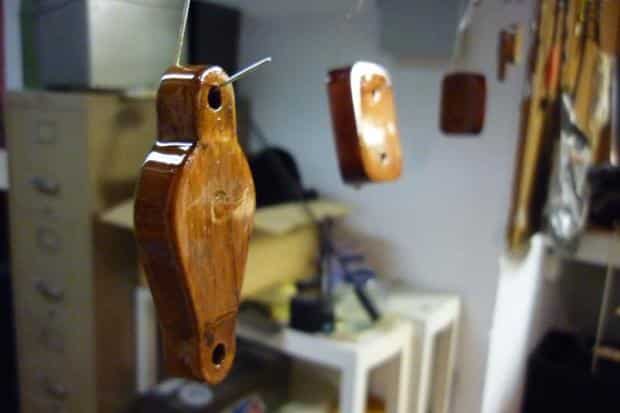
To varnish miscellaneous parts, I strung up a clothesline and hung the pieces from paperclips to dry.
Plus, new tasks keep presenting themselves. The end of varnishing was like the turnaround point, or maybe the point of no return. Before I reinstalled each piece of equipment, I had to consider whether it needed replacement or repair, and whether installing that part would prevent me from accessing another part that needed attention. And as I held the old hardware next to the shiny new varnish, the equipment began to look even more tired than before.

Call me the Michelangelo of spray-foam insulation.
Reinstalling the flotation turned out to be a bit of a detour. Over the years, the custom-contoured blocks of Styrofoam fitted for the bow and stern had begun to crumble, victims of spinnaker poles javelined in the heat of battle and, apparently, some furry rodent who settled down for the winter with a hearty stash of acorns. I sanded off the dirt and flaking paint, and filled the cavities with spray-foam insulation. Sculpting the hardened insulation to match the contours of the flotation blocks turned out to be the most enjoyable part of the entire boat project. You can carve the foam with a serrated knife—borrowed from Mom’s kitchen, of course—and you begin to feel like Michelangelo stripping away the parts that don’t belong. After a few rounds of spraying foam and cutting away the excess, all the indentations were gone. I applied a few coats of latex house paint, and the flotation was ready for installation.
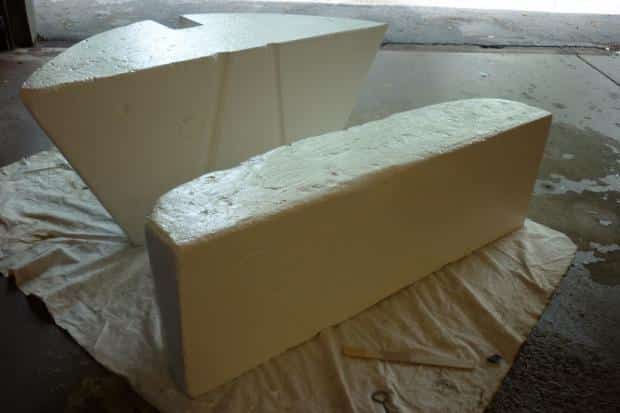
Strangely enough, repairing the flotation was the most enjoyable part of the project.
Or was it? Now, against the snow-white flotation blocks, the black spray paint flaking off the aluminum support bars just wouldn’t do. So I set about sanding those down and giving them a few coats of black spray paint.
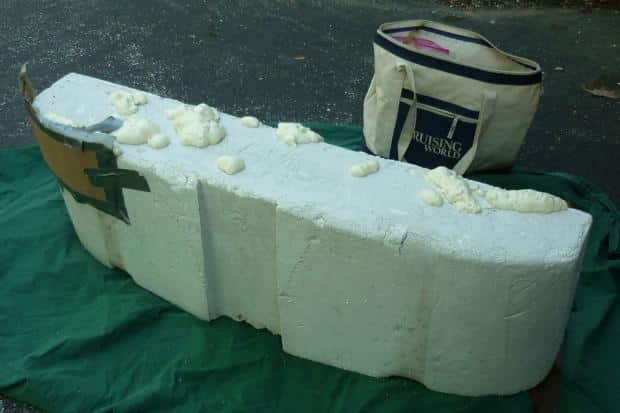
The spray foam has a mind of its own—it seems to expand as it dries.
This is how the past few weeks have gone—one thing after another, each a little more persnickety than the next. Luckily, the Sled‘s only 17-feet long, and there are only so many parts upon which to dawdle! I cleaned up and repaired the old hardware, and replaced the cleats for the hiking strap, topping lift, and cunningham with new Harken Micro Cam Cleats and X-Treme Angle Fairleads—which should make those controls easier to operate from the rail.
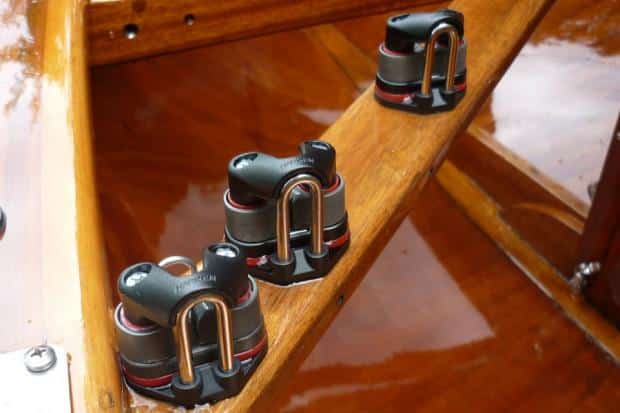
I’m excited to test out these new Harken Micro Cam Cleats with the X-Treme Angle Fairleads.
I varnished the rudder, tiller, and the wooden risers for several blocks and cleats. We filled dings in the centerboard and rudder, and wet-sanded the foils to a smooth, fair finish. I waxed the boom and mast, and tuned the rig.
We smeared some epoxy, augmented with microballoons, to repair the trailing edge of the rudder:
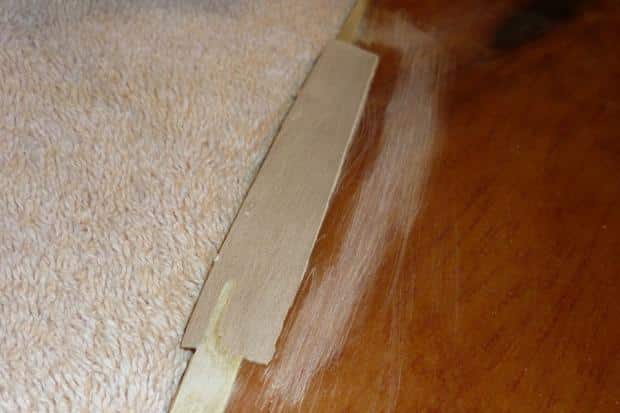
After sanding off the excess epoxy, we revealed the bite mark we repaired:
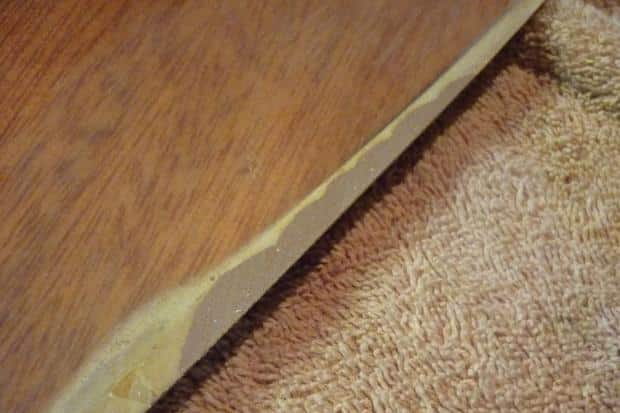
Except the halyards—which are next on the list—I replaced just about every line on the boat. One Saturday morning, I monopolized an hour of time from Jim at my local West Marine. He measured and cut several sections of line and waited patiently as I labeled each segment in the vang’s elaborate purchase system. With so many short lines securing the hiking straps and flotation, I learned to be pretty nimble with my whipping twine and sailmaker’s needles. From a functional standpoint, the old lines could have served for another season or two. But the bright new Sta-Set lines from New England Ropes look a whole lot better.
The new top and bottom covers coming in from Mike Gillum’s GPS Specialty Construction will be icing on the cake. But, of course, we’re not really finished. The trailer demands attention, either from Dad and me, or from the first policeman who spots us. Trailering the Sled the short distance from my parents’ house down to the Cleveland Yachting Club, we had to run a little “Smokey and the Bandit” routine. Dad towed the boat, and I followed in my own car, keeping my vehicle between the faulty trailer lights/ missing license plate and any law enforcement vehicle that might pull up behind me.
We didn’t encounter any authorities, but I did watch in my rearview mirror as woman in a late-model Pontiac ran up on the curb, hip-checked a telephone pole, re-entered the roadway, and continued on her merry way, swerving ever so threateningly behind me. We came to a stoplight. As the Pontiac came barreling toward me in my wife’s new Volkswagen, I considered ducking into a nearby parking lot. For a second, there was a choice: The Volkswagen or the Sled.
An image of 240-grit sandpaper popped into my head, and I pictured the varnishing project set back to square one. It was a long winter of work, and I’m sick of sandpaper. The project has been rewarding, but I don’t think I could do it again. Not now, at least. So I stayed put and prepared to sacrifice the Jetta, and my neck, to the careening Pontiac.
Luckily, the lady found the brakes.
Now, it’s time to go sailing. Truth is, this project has only just begun.









